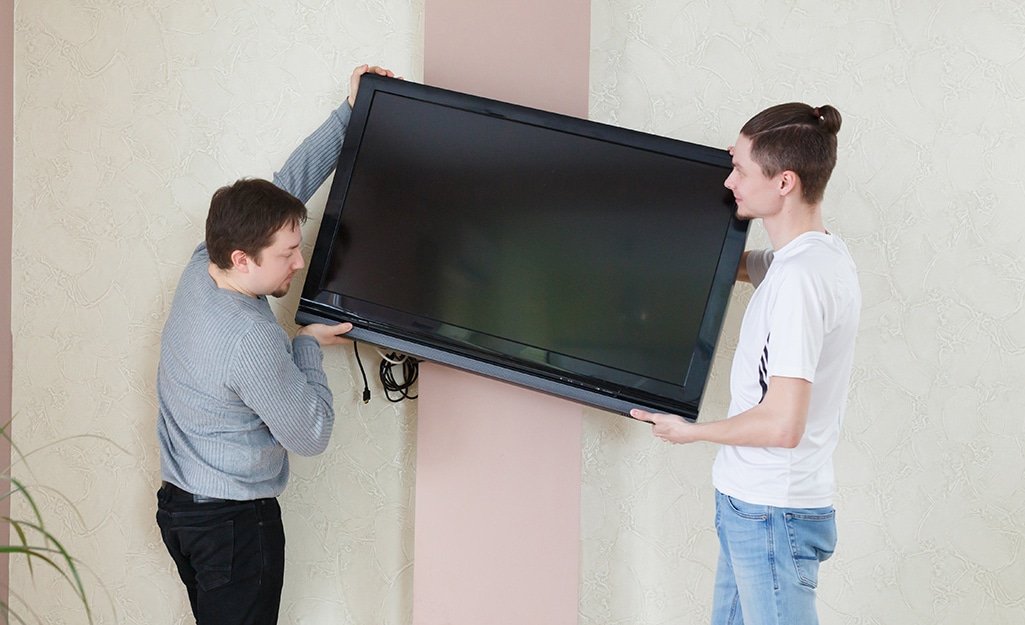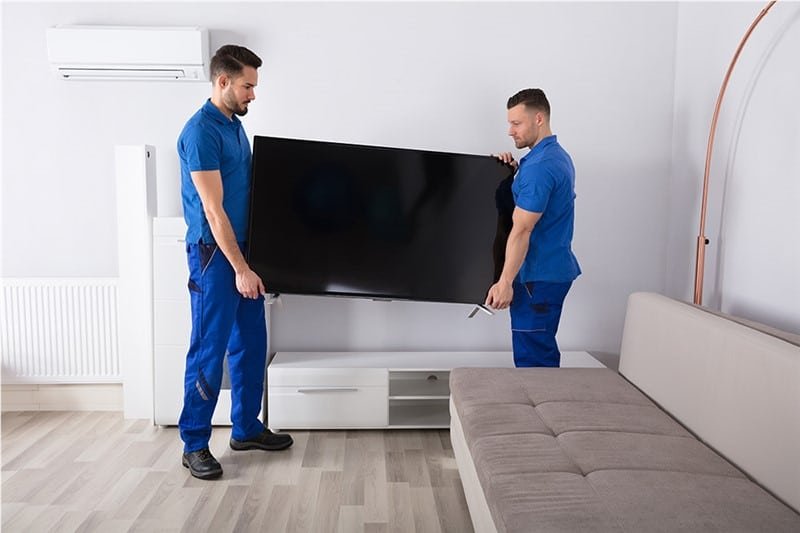Moving a flat screen TV can be one of the most nerve-wracking parts of a relocation. These expensive, fragile, and often oversized pieces of technology are susceptible to damage if not handled with extreme care. A cracked screen or internal component failure can turn your prized entertainment centerpiece into an expensive paperweight. At Top Town Movers, serving Ontario and specifically the North York area, we understand the delicate nature of these electronics. We’ve mastered the techniques to move a flat screen TV safely, and this comprehensive guide will share our professional insights, whether you’re entrusting your TV to us or preparing to move it yourself.
- Learn More >>>>Residential Moving
Why Moving a Flat Screen TV Requires Special Care
Flat screen TVs (LED, LCD, OLED, Plasma) are inherently fragile due to their design:
- Thin Panels: The screens themselves are incredibly thin and can easily crack or shatter under pressure or impact. Even slight bending or twisting can cause irreparable damage to the delicate internal matrix.
- Edge Vulnerability: The edges and corners are particularly vulnerable to impact.
- Weight Distribution: While often appearing light, larger TVs can be surprisingly heavy, and their awkward dimensions make them difficult to grip and maneuver safely.
- Internal Components: Shocks and vibrations during transit can damage sensitive internal circuitry, leading to picture distortion or complete failure, even if the screen appears intact.
Given these vulnerabilities, knowing exactly how to move a flat screen TV is paramount.
- Learn More >>>>500+ Things Gone | How To Declutter Like You Are Moving
Phase 1: Preparation – Before You Touch the TV
Meticulous preparation is the first and most critical step in ensuring your flat screen TV’s safety.
1. Gather the Right Packing Materials:
Do not attempt to move a flat screen TV without the proper supplies. This is not the place to cut corners.
- Original Box and Packaging (BEST OPTION): If you still have the TV’s original box, foam inserts, and protective film, this is by far the safest way to transport it. Manufacturers design these to withstand shipping rigors.
- Specialty TV Box: If you don’t have the original packaging, invest in a specialty TV moving box from a moving supply retailer or a professional moving company like Top Town Movers. These boxes are typically double-walled and expandable to fit various TV sizes, offering superior protection.
- Heavy-Duty Moving Blankets/Quilted Pads: Essential for wrapping the TV and providing cushioning.
- Bubble Wrap: For extra protection around corners and the screen (if not using a form-fitting foam).
- Packing Tape: Strong, wide packing tape for securing blankets and sealing the box.
- Shrink Wrap: Useful for holding blankets in place or securing loose components.
- Marker: For clear labeling.
- Plastic Bags (Ziploc): For remotes, cables, and small parts.
- Screwdriver Set: For detaching the stand.
2. Disconnect and Document:
- Power Down and Unplug: Always turn off and unplug the TV from all power sources.
- Disconnect Cables: Carefully disconnect all HDMI, audio, power, and antenna cables.
- Label Cables: This is crucial for easy re-setup. Use small pieces of masking tape or cable labels to mark which cable goes into which port (e.g., “HDMI 1 – Cable Box,” “HDMI 2 – Gaming Console”). Take a photo of the back of your TV with all cables connected before unplugging – this visual guide will be invaluable.
- Gather Accessories: Collect the remote control, manuals, and any other accessories. Place all cables and accessories in a clearly labeled plastic bag.
3. Detach the Stand or Wall Mount (if applicable):
- Remove the Stand: Most TVs have a detachable stand. Carefully unbolt or unscrew the stand from the TV. Place all screws, bolts, and small parts into a clearly labeled plastic bag (e.g., “TV Stand Screws”) and tape it securely to the detached stand or to the TV’s box.
- Remove from Wall Mount: If wall-mounted, carefully detach the TV from the mounting bracket. Remove the wall mount itself from the wall if you plan to take it. Bag all mounting hardware.
- Protect Detached Parts: Wrap the detached stand or wall mount with bubble wrap or a moving blanket to prevent it from scratching the TV or other items.

- Learn More >>>>The BEST House Moving Tips (and Mistakes to Avoid)!
Phase 2: The Packing Process – Protecting the Screen
This is the most critical phase for how to move a flat screen TV. The goal is to create a secure, padded cocoon for the screen.
Scenario A: Using the Original Box (The Ideal Method)
- Prep the Box: If the original box is folded flat, assemble it according to the manufacturer’s instructions.
- Re-insert Foam Inserts: Place the original foam inserts precisely as they were when you first unboxed the TV. These are custom-molded to fit and provide the best protection.
- Wrap for Extra Safety (Optional but Recommended): Even with original foam, a thin layer of bubble wrap or a soft moving blanket around the TV can add an extra layer of protection against minor abrasions or dust.
- Place TV in Box: Carefully lift the TV (get help if it’s large) and gently lower it into the box, ensuring it fits snugly within the foam inserts.
- Add Accessories Bag: Place the labeled bag of cables and remotes inside the box, ensuring it doesn’t press against the screen.
- Seal and Label: Seal the box securely with packing tape (even if it’s a “tape-free” type for added peace of mind). Clearly label the box on multiple sides:
- “FLAT SCREEN TV – FRAGILE”
- “THIS SIDE UP” (with arrows pointing correctly)
- “HANDLE WITH EXTREME CARE”
- Your name and “Master Bedroom” (or destination room).
Scenario B: Using a Specialty TV Moving Box
If the original box is unavailable, a specialty TV box is your next best option.
- Assemble the Box: Specialty TV boxes often come in two telescopic halves. Assemble one half according to instructions.
- Wrap the TV:
- Screen Protection: Place a soft moving blanket or a large sheet of thick cardboard (larger than the screen) directly over the screen. Secure it loosely with painter’s tape (which won’t leave residue) to prevent it from shifting.
- Full Wrap: Wrap the entire TV (including the screen protection) in at least two layers of heavy-duty moving blankets. Secure these layers tightly with shrink wrap. Ensure corners are particularly well-padded.
- Bubble Wrap (Optional but Recommended): For extra protection, especially if you have very thick bubble wrap, you can add a layer around the entire wrapped TV, securing with shrink wrap or tape.
- Place Foam Corner Protectors: Many specialty TV boxes come with adjustable foam corner protectors. Fit these snugly onto all four corners of the wrapped TV. These are crucial for absorbing impact.
- Place TV in Box: With assistance for larger TVs, carefully lift the padded TV and slide it into one half of the specialty box.
- Adjust and Seal: Slide the second half of the box over the TV until both halves meet. Secure the two halves together with ample packing tape around the entire seam. Many specialty boxes have built-in handles; if so, make sure they are accessible.
- Add Accessories Bag: Place the labeled bag of cables and remotes either inside the box (ensuring it doesn’t press against the screen) or tape it to the outside.
- Label Extensively: As with the original box, label the specialty box clearly on all sides:
- “FLAT SCREEN TV – FRAGILE”
- “THIS SIDE UP” (with prominent arrows)
- “DO NOT LAY FLAT” (This is crucial for large TVs. Laying them flat can cause the screen to crack under their own weight or the weight of items on top.)
- “HANDLE WITH EXTREME CARE”
- Your name and “Master Bedroom.”

- Learn More >>>>The Best Moving Boxes to Make Life Easier
Phase 3: Moving Day – Loading and Transporting Safely
The packing is done. Now, the physical relocation of how to move a flat screen TV begins.
1. Enlist Help:
Never attempt to lift or carry a large flat screen TV by yourself. Always have at least two people, preferably more for very large or heavy models.
2. Proper Lifting Technique:
- Bend at the Knees: Lift with your legs, not your back.
- Maintain Good Grip: Use the box’s handles or grip the sides firmly.
- Keep Upright: Always keep the TV in its upright, vertical position, especially when moving it out of the house and into the truck.
3. Loading into the Moving Truck or Trailer:
- Always Transport Upright: This is the most critical rule. A large flat screen TV should never be laid flat during transport. The forces of gravity and road vibrations can cause the panel to crack under its own weight or the weight of items on top.
- Position Against a Solid Wall: Place the TV box snugly against the side wall of the moving truck (preferably the side that won’t have items pressing against it during turns) or against a sturdy piece of furniture that’s already secured.
- Secure with Moving Straps: Use moving straps or ratchet straps to secure the TV box tightly to the truck’s tie-down points. Ensure there’s no way for it to tip over or slide.
- Pad Around It: Place additional moving blankets or soft items around the TV box to prevent other items from shifting into it during transit. Do not pack heavy items directly against the TV box.
- Avoid Overpacking: Ensure the TV box isn’t subjected to pressure from other items. It should be in a secure, stable position with nothing heavy leaning on it.
- Learn More >>>>Why THESE Boxes Are the BEST for Moving and Packing
4. During Transit:
- Drive Carefully: If you’re driving the moving truck, drive slowly and avoid sudden stops, sharp turns, or rough roads. Potholes and bumps are the enemy of flat screen TVs.
- Monitor Load (if possible): If you’re driving a long distance, consider checking on your TV’s position during rest stops.
Phase 4: Unpacking and Re-installation
You’ve made it! The final steps are just as important to complete the process of how to move a flat screen TV.
1. Unload Carefully:
- Maintain Upright Position: Again, keep the TV box upright as you unload it from the truck and move it into your new home.
- Place in Designated Spot: Take it directly to the room where it will be installed.
2. Unpack Gently:
- Clear the Area: Ensure you have ample space around the TV to unpack it safely.
- Carefully Remove Tape/Box: Open the box and remove the TV gently. Take care not to touch the screen directly with your fingers, especially if you have sensitive hands (use gloves if preferred).
- Save Packing Materials: If you plan to move again, save the specialty box and foam inserts.
3. Re-install and Reconnect:
- Attach Stand/Wall Mount: Re-attach the TV stand or mount it to the wall according to instructions.
- Reconnect Cables: Refer to the photos you took or the labels you made to reconnect all cables to their correct ports.
- Power On and Test: Once fully set up, power on your TV and test all functions.
- Learn More >>>>How to Assemble the Four Piece Mirror & Picture Box
The Top Town Movers Professional Advantage
At Top Town Movers, serving North York and the entire Ontario region, we handle valuable and delicate items like flat screen TVs with the utmost professionalism. When you choose us, you benefit from:
- Expert Packing: Our teams are trained in the BEST for Moving and Packing techniques for electronics, using high-quality materials.
- Specialized Equipment: We have the right tools, including custom TV boxes, heavy-duty moving blankets, and dollies, to ensure safe transport.
- Secure Loading: Our movers are skilled in proper weight distribution and securing delicate items within the moving truck to prevent shifting and damage.
- Insurance and Protection: We offer valuation coverage options to give you peace of mind regarding your valuable electronics.
By understanding how to move a flat screen TV correctly, whether you do it yourself or rely on the expertise of Top Town Movers, you’re taking the most important step in protecting your investment and ensuring your entertainment system is ready for action in your new Ontario home.

































